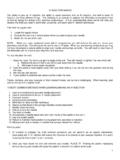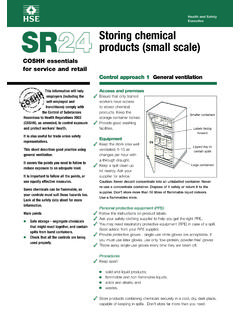Transcription of IV INJECTION BASICS - R-VETS
1 1 IV INJECTION BASICS The ability to give an IV INJECTION , the ability to assist someone with an IV INJECTION , and skill to teach IV INJECTION are three different things. The following is an attempt to address the difficulties encountered most commonly during the period when learning venipuncture. A true understanding these points will help you develop the skills you need to administer, supervise, and teach safe IV INJECTION techniques. First, find the jugular vein; 1. Locate the jugular furrow 2. Occlude the vein 3 to 6 inches below where you plan to place your needle. 3. Watch for the rise of the vein. NOTE: When you have developed some skill in venipuncture, you will occlude the vein just below your planned puncture site. This will cause the vein to rise or fill faster. When you are learning venipunture you may not have developed a natural ability to align your needle and syringe correctly.
2 You will need to view more of the distended vein to improve your alignment and accuracy. To help visualize the vein; 1. Raise the head. Try not to change the angle at the poll. This will stretch or tighten the vein which will; a. Reduce the amount that it can roll or push away from the needle. b. Will make it more easily visualized. 2. Push the patients head slightly away from you while holding it up. Do not turn the patients head during this step. 3. Wet the hair with alcohol. 4. If your patient is anesthetized, place a pillow under the neck. Ponies, donkeys, and very muscular or thick necked horses, can be more challenging. When learning, start with an animal with a slighter build. 13 MOST COMMON MISTAKES WHEN LEARNING/MAKING AN IV INJECTION 1. Lack of commitment to accurate needle placement. 2. Lack of commitment to the act of needle placement. 3. Incorrect location.
3 4. Incorrect bevel orientation. 5. Blind stick or stick and fish technique. 6. Assuming that blood in the syringe indicates correct placement. 7. Needle angle too steep. 8. Failure to bury the needle. 9. Too short a needle. 10. Subcutaneous needle placement (with only the tip of the needle in the vein.) 11. Use of a dulled needle. 12. Failure to maintain hand position during placement, aspiration or INJECTION . 13. Misalignment due to viewpoint (needle and syringe viewed from above) Point by point: 1. IV INJECTION is probably the most common procedure you will perform as an equine veterinarian. Developing skill in IV INJECTION will reduce the chances of an arterial or peri-vascular INJECTION . It is worth investing the time to learn to do it correctly. 2. Once you have found the vein and oriented your needle, PLACE IT! Pricking the patient repeatedly without placing your needle will cause the patient to become im-patient at the least.
4 2 4. Placement of the needle into the vein should always be done with the bevel facing toward you. 3. IV injections should be given in the upper portion of the neck (closer to the head). a. Closer to the head of the horse there is a muscle (the omohyoideus) between the artery and the vein, decreasing the chances of an arterial stick. b. Closer to the body of the horse the artery is more superficial and closer to the vein. Venipuncture in this part of the neck increases the chance of an arterial puncture and INJECTION . Until you have given thousands of jugular injections using sound technique, you may lack the skill required to avoid arterial INJECTION . GOOD NO JUGULAR VEIN AND COMMON CAROTID ARTERIAL ANATOMY AS IT AFFECTS THE IV INJECTION 3 5. The stick and fish technique increases the chances of an arterial stick. a.
5 Find the vein before placing your needle. b. If you believe you have found the vein, yet are unable to obtain a flash, rotate the hub of the needle as directed above. c. DO NOT fish blindly d. DO NOT pull the needle out. The skin stick is the step that generally bothers your patient the most. In order to redirect accurately, you must find where you have placed the needle in relation to the vein. Take a few moments. Feel the needle. Is it sub-q? Watch the hub of the needle. Occlude and release the vein. The movement in the needle will help you see where it is in relation to the vein. Skipping this step cheats you out of a valuable learning exercise that can help you improve your accuracy and costs your patient an extra stick. 6. Many practitioners place the needle and syringe as a single unit. This is appropriate for a skilled practitioner. When learning, it is a good idea to disconnect the needle from the syringe during placement.
6 A. Overestimating the depth of the vein is common b. You cannot distinguish vein from artery by aspiration of blood into your syringe. c. Once the needle is placed, continue occlusion of the vein and watch for blood dripping from the needle. An arterial puncture will pulse. 8. Failure to bury the needle (advance completely) increases the risk of two common errors. NEEDLE ENTERS ARTERY AS IT IS ADVANCED TOO GREAT AN ANGLE VEIN VEIN ARTERY a. Correct bevel orientation decreases resistance to skin puncture. b. Incorrect bevel orientation can cause the bevel to rest flat against the wall of the vein, occluding the lumen. c. If you feel you have placed the needle correctly but have no flash or drop of blood in the hub of the needle, occlude the vein and rotate the needle by twisting the hub. 7. The Jugular vein is very shallow (review ultrasound in #2).
7 A. Only skin lies between your needle and the vein b. As the angle increases, so does the risk of running the needle into the artery. Angle Too Steep Correct Alignment and Orientation 4 a. Your needle is more likely to come out of the vein during INJECTION , causing perivascular drug administration. b. If your needle is pushed deeper by the patient s movement toward you, the needle may be pushed deeper, causing an arterial INJECTION . To avoid these problems, once the tip of the needle is within the lumen of the vein, orient the needle parallel to the vein and bury it (advance the needle until all that is visible is the hub). 10. A needle placed using sound technique will pierce the skin and immediately enter the vein. It will not run subcutaneously before it enters the vein. 11. Each time a needle punctures anything it becomes dulled.
8 Dulled needles cause significantly more pain. For this reason a new needle should always be placed on your syringe prior to administration of an INJECTION to an un-anesthetized patient. 13. Another common misalignment. From the perspective of the administrator (looking down onto the needle and syringe) this may appear to be properly aligned. Even a slight shift in hand position during aspiration may cause the vein to be lost LONG NEEDLE WILL SEAT WELL AND ACT MORE LIKE A CATHETER SHORT NEEDLE WILL NOT SEAT WELL 12. Shifting the hand position (and needle, and syringe) during aspiration. Focus on: a. Maintaining the correct vein/needle/syringe alignment as you aspirate b. Maintaining a very still hand position during aspiration. To help you do this, brace your hand against the patient. Needle position not parallel to vein 9. A 1 needle is more likely to remain in the vein if the patient moves.
9








